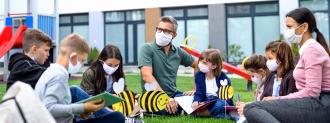With fall fast approaching, U.S. officials are on the hunt for ways to reopen schools in the midst of a pandemic without risking the health of students and teachers.
But while the CDC recommends they consider one-way halls, staggered class schedules, and plastic barriers, the agency appears to be overlooking a seemingly simple, tried-and-true way to protect students from infectious diseases: outdoor classrooms.
The First Outdoor Classrooms
One of the few constants in our understanding of the novel coronavirus has been its inability to spread outdoors as easily as it spreads indoors.
Moving classes outdoors, then, seems like an obvious way to protect students, but a recent New York Times investigation found little interest in this approach among government officials.
This is particularly puzzling, given its long history of working in similar situations.
In 1907, a pair of doctors in Rhode Island proposed creating open-air classrooms — ones with ceiling-height open windows on all four walls — to stem the spread of tuberculosis among students.
Moving the students outdoors for that first open-air classroom wasn’t without its challenges — the Rhode Island winter was harsh — but the students bundled up, the teacher served hot soup, and they got through the year without any children contracting TB.
Within a couple of years, 64 other schools in the U.S. were teaching students in either open-air classrooms or just outdoor classrooms — at one school, classes were held on a roof, and at another, students gathered on an abandoned ferry, according to the NYT.
Class in Session
At-home learning might stem the spread of COVID19, but as experts have pointed out, it comes at a cost — the format can increase students’ chances of falling behind academically, exacerbating mental health issues, and even experiencing food insecurity.
For those reasons and others, reopening schools this fall should be a priority, according to a new report by the National Academies of Sciences, Engineering, and Medicine.
Outdoor classrooms have a long history of working in similar situations.
Unlike the CDC, that group does specifically recommend that officials consider outdoor classrooms as a way to safely get students back in school — it even provides an estimated budget for making the transition ($5,000 to $10,000 per classroom).
While adopting outdoor classrooms could be more challenging in the fall of 2020 than it was in 1908 — far more children attend school now than did a century ago, and the education system is more heavily regulated — if the approach can get kids back in school, it might be worth the effort.
“I do think it’s doable,” Liat Olenick, a Brooklyn school teacher, told the NYT. “Do I think it will be easy? No. But given that all our other choices are terrible it is worth considering.”
We’d love to hear from you! If you have a comment about this article or if you have a tip for a future Freethink story, please email us at tips@freethink.com.






